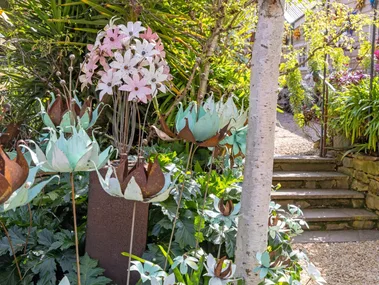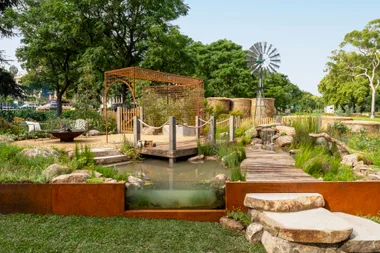Venture deep into a rainforest and you can be overwhelmed by its magnificence. There’s an abundance of greenery with tall trees, climbers clambering up their trunks, epiphytes snuggled in their branches and carpets of groundcovers. Through the filtered light, you may spot bright pops of colour from crimson foliage or golden flowers.
It’s a tranquil retreat that you can re-create in your own garden, then sit on a stump and feel grateful you no longer need to mow the lawn in the hot sun.

Why should you plant a rainforest garden?
A rainforest garden creates a microclimate where summer temperatures drop. That’s because plant leaves transpire water and the canopy provides shade. In winter, your rainforest garden protects you from cold winds and chilly air. The likelihood of severe frosts is also reduced.
How to prepare for your rainforest garden
- Before planting, remove all grass and weeds. Cultivate your soil, turning it over and adding organic matter so it’s aerated, becomes rich in nutrients and is well drained. Top off with organic mulch such as leaf litter, straw or untreated bark chips. This ensures the roots of trees you plant have a cool, moist environment.
- Create a water feature such as a pond or a stream to help create the humid atmosphere rainforest plants need. Or set up a sprinkler system with a mist spray nozzle set high in the canopy to simulate rainfall.
- Make a pathway, ideally with natural materials such as bark chips or pebbles, lined with logs or rocks. Rainforest plants drop many leaves all year round and spending time clearing them off concrete paths defeats the purpose of having a rainforest garden.

Planting your rainforest garden
- Put in your canopy trees first. They stretch high to get sunlight, and then provide shade for understorey plants, protecting them from harsh elements in both summer and winter. Their shade also helps prevent weeds from popping up.
- Plant them 2–3 metres apart so you eventually have density. Rainforest canopy trees include palms, tree ferns, the Illawarra flame tree, native quandong, the cheese tree and macadamia trees. Once the canopy is established – it may take a couple of years – put in shade-loving shrubs. Ferns come into their element here – try giant maidenhair, bird’s nest, hare’s foot, or hen-and-chicken. For colour, add heucheras, New Guinea impatiens and begonias. Philodendrons and monsteras add volume.
- Next, put in groundcovers such as native violets, ajugas and epimediums.
- Climbers such as the giant pepper vine, the shingle plant and the resin vine will scramble up trees searching for sunlight.
- Finally, tie epiphytic plants, such as orchids and bromeliads, to the branches of the trees.

The Alchemy of a Rainforest in The Calyx at the Royal Botanic Garden in Sydney is a great example of a rainforest garden. You can visit this established space until 2026 from 10am-4pm daily. Visit the Royal Botanic Gardens website for more information.
Need inspiration? Visit The Calyx
5 rainforest plants that are great for gardens

Tropical stromanthe
S. sanguinea ‘Tricolor’
The vibrant leaves of the tropical stromanthe (S. sanguinea ‘Tricolor’) are real eye-catchers with deep green, pink and white variegations. The leaves dazzle even further with rich red or crimson undersides.

Satin pothos
Scindapsus pictus
Satin pothos vines produce anchoring roots from their stems that cling to surfaces. The foliage grows flat, hugging the surface they’re growing on as they climb to the light.

Rex begonias
Begonia rex
The intricate leaf patterns of rex begonias come in rich silver, bronze, red, purple, and black colour. They form dramatic splatters, swirls and polka dots that rival constellations. Rex begonias are originally from the steamy parts of Asia and love humidity.

Palms
Arecaceae
You may associate palms with tropical beaches or a desert oasis, but most palm species are found in tropical rainforests.

Aglaonemas ‘Spitfire’
Aglaonema modestum
The bright pink, red or crimson variegations of aglaonemas ‘Spitfire’ are more intense if you plant them where they get bright, indirect light.



